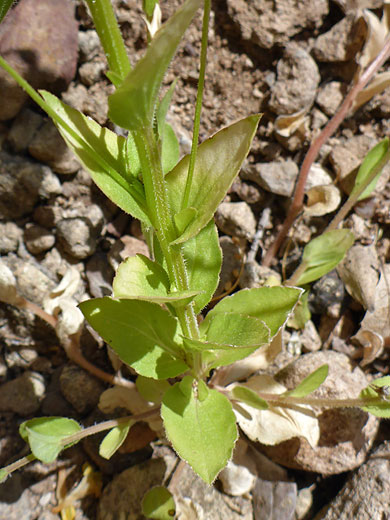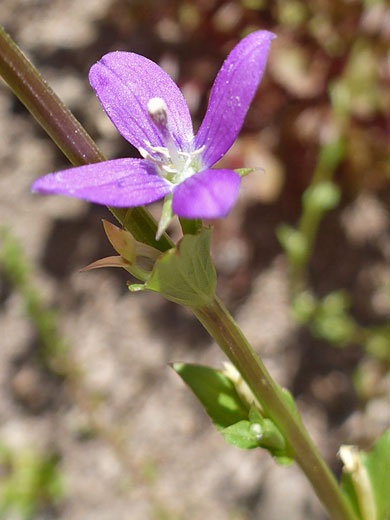Triodanis Holzingeri, Holzinger's Venus' Looking Glass
Plants > Wildflowers > Campanulaceae > Triodanis Holzingeri

Purple, five-petaled flower of triodanis holzingeri - Mesquite Creek, Superstition Mountains, Arizona
Common name:
Holzinger's venus' looking glass
Family:
Scientific name:
Triodanis holzingeri
Main flower color:
Range:
South Arizona, and south Texas northwards into the Great Plains
Height:
Up to 15 inches
Habitat:
Streambanks, canyons, sandy washes
Leaves:
Alternate, oblanceolate to ovate, clasping, up to 1.5 inches long, with toothed edges
Season:
March to May
The green or reddish stems of triodanis holzingeri - one of six US species in this genus - are rigid and ribbed, the ribs lined by small, bristly, reflexed white hairs. Plants branch from the base, or may be unbranched. Leaves grow along the stem and are mostly sessile apart from the lowest few which may have short stems. Leaf margins are lined by fine teeth, quite well separated, and are usually ciliate. The margins may be slightly purplish. Leaves and stem contain a milky sap.
Flowers form singly or in groups of up to three from the uppermost leaf nodes, though only one per node is in bloom at any particular time. Flowers are sessile, lacking pedicels. They have a green calyx terminating in five small, narrowly triangular sepals, and a richly-colored, bluish purple corolla, opening to five spreading lobes, around a third of an inch long. The lobes are crossed by a few darker, lengthwise veins. The lobes are white at the base. At the center of the flower are a protruding pistil and five shorter white stamens.
Flowers form singly or in groups of up to three from the uppermost leaf nodes, though only one per node is in bloom at any particular time. Flowers are sessile, lacking pedicels. They have a green calyx terminating in five small, narrowly triangular sepals, and a richly-colored, bluish purple corolla, opening to five spreading lobes, around a third of an inch long. The lobes are crossed by a few darker, lengthwise veins. The lobes are white at the base. At the center of the flower are a protruding pistil and five shorter white stamens.
All Contents © Copyright The American Southwest | Comments and Questions | Contribute | Site Map


